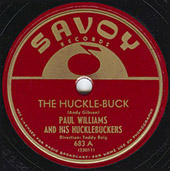
Swing dance is a group of social dances that developed with the swing style of jazz music in the 1920s–1940s, with the origins of each dance predating the popular "swing era". Hundreds of styles of swing dancing were developed; those that have survived beyond that era include Charleston, Balboa, Lindy Hop, and Collegiate Shag. Today, the best-known of these dances is the Lindy Hop, which originated in Harlem in the early 1930s. While the majority of swing dances began in African-American communities as vernacular African-American dances, some influenced swing-era dances, like Balboa, developed outside of these communities.

Popping is a street dance adapted out of the earlier boogaloo cultural movement in Oakland, California. As boogaloo spread, it would be referred to as "robottin'" in Richmond, California; strutting movements in San Francisco and San Jose; and the Strikin' dances of the Oak Park community in Sacramento, which were popular through the mid-1960s to the 1970s.
Crunk is a subgenre of southern hip hop that emerged in the early 1990s and gained mainstream success during the early to mid 2000s. Crunk is often up-tempo and one of Southern hip hop's more nightclub-oriented subgenres. Distinguishing itself with other Southern hip hop subgenres, crunk is marked and characterized by its energetic accelerated musical tempo, club appeal, recurrent chants frequently executed in a call and response manner, multilayered synths, its pronounced reliance on resounding 808 basslines, and rudimentary musical arrangement. An archetypal crunk track frequently uses a dominant groove composed of a nuanced utilization of intricately multilayered keyboard synthesizers organized in a recurring pattern, seamlessly shifting from a lower to a higher pitch that encompasses the song's primary central rhythm, both in terms of its harmonic and melodic aspects. The main groove is then wrapped up with looped, stripped-down, and crisp 808 dance claps and manipulated snare rolls coupled and accompanied by a bassline of thumping 808 kick drums. The term "crunk" was also used throughout the 2000s as a blanket term to denote any style of Southern hip hop, a side effect of the genre's breakthrough to the mainstream. The word derives from its African-American Vernacular English past-participle form, "crunk", of the verb "to crank". It refers to being excited or high on drugs.

Hip hop dance is a range of street dance styles primarily performed to hip hop music or that have evolved as part of hip hop culture. It is influenced by a wide range of styles that were created in the 1970s and made popular by dance crews in the United States. The television show Soul Train and the 1980s films Breakin', Beat Street, and Wild Style showcased these crews and dance styles in their early stages; therefore, giving hip-hop dance mainstream exposure.
Thomas Johnson, also known as Tommy the Clown, is an American dancer best known as the inventor of the "clowning" style of dance, which evolved into krumping. Johnson invented the style in 1992 to enhance birthday party clown acts, thereby creating the concept of "hip-hop clowns". Johnson and his followers have performed at birthday parties ranging from inner city communities to celebrities like Madonna, Pamela Anderson, and Cedric the Entertainer. He achieved international acclaim as the focus of David LaChapelle's 2005 documentary Rize. Tommy the Clown also danced with Ray Ray, of Mindless Behavior fame.

In weight training, a kettlebell is a cast-iron or cast-steel ball with a handle attached to the top. It is used to perform many types of exercises, including ballistic exercises that combine cardiovascular, strength and flexibility training. Kettlebells are the primary equipment used in the weight-lifting sport of kettlebell lifting.

Rize is an American documentary film by David LaChapelle, starring Lil' C, Tommy the Clown and Miss Prissy. It documents the culture and competition surrounding two dance forms, clowning and krumping. It released in 2005.
Locking is a style of funk dance, which is today also associated with hip hop. The name is based on the concept of locking movements, which means freezing from a fast movement and "locking" in a certain position, holding that position for a short while and then continuing at the same speed as before. It relies on fast and distinct arm and hand movements combined with more relaxed hips and legs. The movements are generally large and exaggerated, and often very rhythmic and tightly synced with the music. Locking is performance oriented, often interacting with the audience by smiling or giving them a high five, and some moves are quite comical.

African-American dance is a form of dance that was created by Africans in the Diaspora, specifically the United States. It has developed within various spaces throughout African-American communities in the United States, rather than studios, schools, or companies. These dances are usually centered on folk and social dance practice, though performance dance often supplies complementary aspects to this. Placing great value on improvisation, these dances are characterized by ongoing change and development. There are a number of notable African-American modern dance companies using African-American cultural dance as an inspiration, among these are the Whitey's Lindy Hoppers, Alvin Ailey American Dance Theater, Dance Theatre of Harlem, and Katherine Dunham Company. Hollywood and Broadway have also provided opportunities for African-American artists to share their work and for the public to support them.
J-Swift is a Spanish music producer responsible for songs with groups on the Delicious Vinyl label. He has produced the hip hop groups The Pharcyde and The Wascals.
Wu-tang is a dance originating in Philadelphia before spreading throughout the surrounding region. The dance is normally performed to Baltimore club music. The dance involves a jerking of the arms in an up-and-down/side-to-side motion. The movement of the arms sometimes resembles flexing. Each individual person adds their own spin to the dance, be it fancy footwork or the mimicking of gunshots.
Gangsta Walking, also known as G-Walk, Buckin', Tickin', Jookin', and Choppin', is an African American street dance that began among African-American communities in Memphis, Tennessee in the 1980s.
Christopher "Lil' C" Toler is an American dancer and choreographer best known for his choreography and judging on the TV show So You Think You Can Dance, and for his appearance in the 2005 krumping documentary Rize. Since appearing in the film he has danced for several musical artists including Missy Elliott, Fall Out Boy, and Madonna, and was cast as a featured dancer in the 2007 art exhibit Slow Dancing. He continues to serve as a guest judge on So You Think You Can Dance.

Breakin’ Convention is an international hip-hop theatre festival based in London, England that was founded in 2004 and is produced annually by Sadler's Wells theatre. It has been under the artistic direction of playwright and dancer Jonzi D since its inception. Since May 2008 Breakin’ Convention has expanded its activity beyond the three-day festival to include tours across the UK, developing new theatre work with local hip-hop artists, and to produce year-round professional development courses for UK-based hip-hop choreographers, artists, and dance/theatre companies.

The World Hip Hop Dance Championship is an international hip-hop dance competition created in 2002 by Hip Hop International co-founders Howard and Karen Schwartz, who also created the competitive dance reality television series America's Best Dance Crew. The competition is considered the largest dance competition in the world with more than 50 countries competing each year. The competition has been held since its inception in 2002, except in 2020 due to the COVID-19 pandemic.

"The Hucklebuck" is a jazz and R&B dance tune first popularized by Paul Williams and His Hucklebuckers in 1949. The composition of the tune was credited to Andy Gibson, and lyrics were later added by Roy Alfred. The song became a crossover hit and a dance craze, in many ways foreshadowing the popular success of rock and roll a few years later. It was successfully recorded by many other musicians including Lucky Millinder, Roy Milton, Tommy Dorsey, Frank Sinatra, Lionel Hampton, Louis Armstrong, Chubby Checker, Bo Diddley, Otis Redding, Quincy Jones, Canned Heat, Coast to Coast, Brendan Bowyer and Crystal Swing.
Shimmy is a fitness television series broadcast in Canada on ONE: The Mind and Body Channel that emphasizes the health benefits of belly dance. The twenty-six episode series was designed by and created by Kim Pechet, a belly dance instructor and fitness professional. An original Canadian production, Shimmy premiered October 1, 2007 on ACCESS and CLT in Canada as well as in the United States on Discovery Health and OWN. Shimmy has been broadcast throughout Central and South America, Germany, and India as well as in Canada and the United States.

Christian Joel Jones, better known by his stage name TeeFlii, is an American singer, songwriter, rapper, record producer, and dancer from South Los Angeles, California. He is best known for his 2014 single "24 Hours", which entered the Billboard Hot 100. The song, released by Epic Records, served as the lead single for his debut studio album Starr (2015), which failed to chart. Also in 2014, he co-wrote the single "Show Me" for fellow California rapper Kid Ink, which peaked at number 13 on the Billboard Hot 100.
Mark Saint Juste also known as Mark St. Juste is an entrepreneur, television, film and record producer, author and former school teacher. Over the course of his entertainment career he has written, produced and distributed music that has reached the Billboard charts under his independent record label and production company, Street Street Communications. He also wrote, produced and directed Peep Diss Videos, a prime time syndicated Hip-Hop TV show on broadcast television and three documentary films, Shake City 101, Black Beach and Black Beach Weekend. Saint Juste has worked with some of hip-hops most notable artists to successfully explore the realities of hip-hop and leverage its positive messages for the advancement of communities.
Miss Prissy is an American dancer known for the krumping style. She has been called The Queen of Krump.










